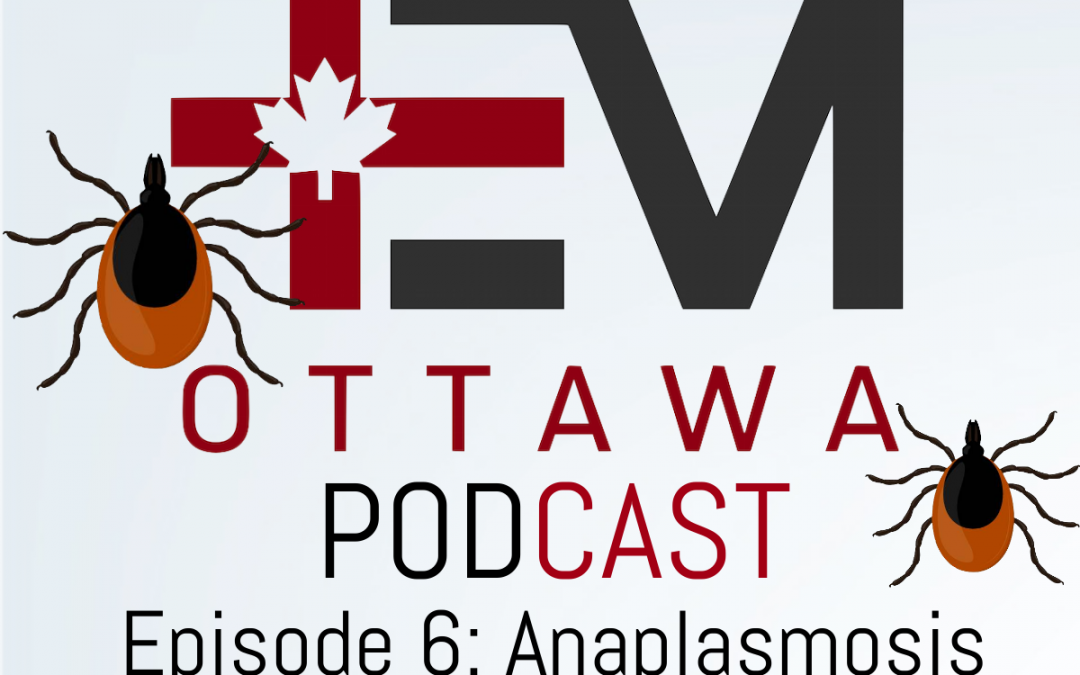
Episode 7: Anaphylaxis Part 2, Ready for Discharge
In part 2 of our 2-part series on Anaphylaxis, our host Dr. Rajiv Thavanathan interviews Dr. Graham Wilson, PGY4 Emergency Medicine at the University of Ottawa and Dr. Derek Lanoue, PGY3 Internal Medicine, University of Ottawa who will soon be an Allergy and Immunology Fellow starting July 1, 2022.
If you haven’t already, you should check-out Part 1 of the series, where the new definition for anaphylaxis and treatment guidelines, including the use of steroids were discussed.
In this part 2, let’s delve deeper into the subject, by discussing monitoring times, discharge instructions and follow-up.
Anaphylaxis Monitoring Times
Although easy to treat with the use of epinephrine, anaphylaxis management is labour intensive in the emergency department with regards to cost effectiveness and human resources, due to the often long “observation” time in the ED. These observation times have a single purpose – monitor for a refractory/biphasic reaction.
Throughout the literature on the topic, there is a wide variation on what is perceived to be an acceptable “mandatory” observation time [range extends between 2-24hrs]. Given the lack of consensus on a set timeframe, some literature has focused on trying to identify this value. A recent study by Ellis has successfully identified that the NPV for the observation of biphasic reaction only increases by 1% for every hour since time of epinephrine injection. This is one of the landmark trials questioning the need for extended observation, primarily for low-risk asymptomatic individuals 1-2hrs post epinephrine injection.
With these promising results, it wouldn’t be inconceivable to think that in the not-so-distant future, risk stratification could be used, and shorter observation periods considered for low-risk individuals. This would certainly help with the human/costly resources needed for extended observation periods.
This conclusion somewhat aligns itself with the 2020 Anaphylaxis guidelines which suggest firmly that high-risk patients require observation for a minimum of 6 hours. These high-risk patients are defined by:
- Risk Factors: Lack of EMS services, Poor self-management skills, cardiovascular risk factors, and lack of access to epinephrine
- Requirement for several doses of epinephrine
- Severe anaphylaxis
Anaphylaxis Mimics: What the ED MD needs to know
Even anaphylaxis has its mimics. These diagnoses are hard to elicit in the moment when a patient presents to the ED with stridor, wheezing and respiratory distress. As such, it’s completely understandable that most ED physicians will provide these patients with at least 1 dose of epinephrine up front. However, if the patient is not responding to epinephrine, there are a few diagnoses that we should perhaps consider.
- Chronic urticaria [including dermatographism]: This condition, whose pathophysiology is best explained as a hypersensitivity reaction, results in exaggerated weal and flare response to a stimulus – for example physical pressure (being stroked or scrathched) in the case of dermatographism. The condition may respond to the use of antihistamines. It often is an anaphylaxis mimicker when the urticaria is perioral and/or associated with a panic attack, resulting in the physical presentation of tachypnea and dyspnea.
- Vocal cord dysfunction: This entity is often seen in individuals with allergies to perfumes or other aerosolizing products. In anaphylaxis cross-linking of IgE results in mast cell degranulation. Aromatic rings found in perfumes are incapable of cross-linking IgE or entering the blood stream, and as a result only stimulate a localized hypersensitivity reaction.
In addition to the above mimics, there are several instances when seeing a patient, where the dx of anaphylaxis seems clear from a symptom’s perspective, but the identification of triggers is difficult. It’s important to remember that idiopathic anaphylaxis is a medical entity of its own and is defined by sx of anaphylaxis with no clear trigger.
Furthermore, with the arrival of Lonestar ticks in Canada, Alpha-Gal [sugar molecule found in mammals] allergies from tick bites may gain prevalence. These anaphylactic presentations often are associated with anaphylaxis that wakes a patient up at night, as they encounter a delayed anaphylactic reaction to red meat.
Patient Discharge and Follow-up
Our general threshold for prescribing an epinephrine autoinjector upon discharge should be very low. If you suspect anaphylaxis in any shape or form, it is always safer to simply Rx an autoinjector. Remember that idiopathic anaphylaxis [i.e. anaphylaxis without a clear trigger] is a medical entity, and therefore if you aren’t able to identify a trigger, but their symptoms were consistent with anaphylaxis, you SHOULD prescribe an autoinjector.
Apart from good discharge instructions on when to seek emergency medical attention, how to use their autoinjector safely, a good follow-up is needed for patients presenting with a first-time episode of anaphylaxis. Although human resource constraints for allergist are pronounced in some regions, a referral to a specialist is often beneficial in these individuals. Even if the “trigger” is clear, and the diagnosis of anaphylaxis is clear cut, these patients often have several lingering questions and a need for supports, as this dx will be a “lifelong” struggle. Our allergy specialists can help provide support and reassurance to individuals even if diagnostic clarification is not required.
Take-Home Points
[TAKE HOME #1] There is ever growing evidence that observation times in the ED can be adjusted based on risk stratification. Although not quite ready for primetime, remember that those with high-risk features [listed below] should be observed for an extended period [i.e. >6hrs].
- Cardiovascular disease
- Lack of EMS services
- Lack of access to epinephrine
- Poor coping skills
[TAKE HOME #2] Even anaphylaxis has mimics. Consider alternative diagnoses including chronic urticaria and vocal cord dysfunction when epinephrine does not help.
[TAKE HOME #3] Every patient with suspected anaphylaxis should be discharged home with a Rx for an autoinjector, and counselled on it’s use/reasons to return to the ED.
[TAKE HOME #4] Referral to an allergist is not just for dx clarification. It provides an additional line of support for a patient who received an anaphylactic dx that will affect them the rest of their lives.
For more information make sure to check out the EMOttawaBlog post on ANAPHYLAXIS in the ED.




